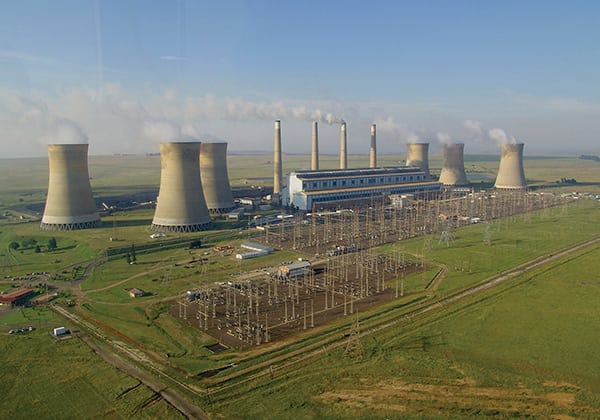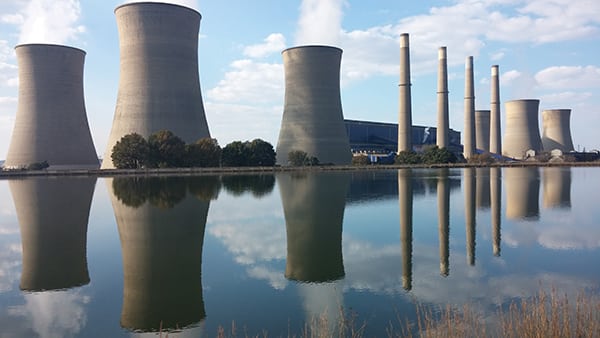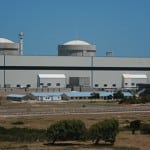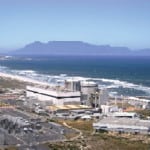South Africa began mothballing coal-fired plants almost 25 years ago when reserve margins were high and independent power producers (IPPs) were invited to invest. Ten years later, mass electrification, rapid industrialization, and low power prices that failed to attract IPPs caused reserves to dip to dangerous levels. Camden was one of three coal plants brought out of retirement to keep the lights on.
Eskom, South Africa’s largest utility, was established in 1923 as the Electricity Supply Commission and was converted into a public company, wholly owned by the government, in July 2002. Eskom produces about 95% of the country’s electricity and 45% of Africa’s total demand. The utility has a generation capacity of about 42 GW and plans to double its capacity by 2030. About 90% of South Africa’s electricity is generated by coal-fired stations, 5% by its single nuclear plant, and the remaining 5% by hydroelectric and pumped storage plants. South Africa has very meager conventional natural gas resources, and though there are potential shale gas deposits, none have been developed.
Resource Planning Problems
Construction of new power facilities in South Africa was once a brisk business, with 31 GW of new capacity built between 1970 and 1990. In 1989, Eskom found itself with substantial surplus capacity and a reserve margin exceeding 25%, yet it still projected a need to build new power stations by 2007, particularly coal and pumped storage facilities, to meet the demands of its expanding economy and mass electrification.
Government regulators believed that investment in private power generation would balance the expected power deficit, but low power prices failed to attract independent power producers. South Africa’s mass electrification program that began in the early 1990s and the ongoing rapid industrialization of the country began to put enormous strain on the electricity supply system. Reserve margins slid to less than 5% by 2008 after virtually no investment in power infrastructure for almost 20 years.
In 2003, rising electricity demand and dwindling power supply margins finally convinced government regulators to approve Eskom’s plans for building new power and transmission infrastructure. Eskom also began reinvigorating its generation fleet by bringing plants out of retirement and refurbishing many of its middle-aged plants as the quickest and least-expensive first step to meet the country’s insatiable appetite for electricity. Simultaneously, Eskom began work on a new generation of large-scale, high efficiency coal-fired plants as well as demand-side management and improved system efficiency programs to trim demand growth. As an immediate first step, Eskom added 1,000 MW of diesel-fired combustion turbines to provide new capacity as demand continued to rise.
South Africa began to experience widespread rolling blackouts, culminating in the first government-declared national electricity emergency, on what has become known as Black Friday, Jan. 25, 2008. Escalating power demand forced Eskom in March 2014 and three times in June to again declare a grid emergency and implement load shedding when demand rose to 36 GW during the evening peak period for the first time since Black Friday.
Refurbished Power Plants
The Camden Power Station was the first plant selected by Eskom for its return-to-service program. Camden consists of eight 200-MW units with a design efficiency of approximately 33.4%. Original site work began in November 1962. The first unit was commissioned in April 1967, with the remaining units commissioned through 1969. At the time, Camden was the starting point of the national power grid that used 400-kV lines to interconnect the country.
Half of Camden’s units were decommissioned in 1988, and the remaining four units followed in 1990 (also mothballed were the Komati and Grootvlei coal-fired stations that have also since been recommissioned). Camden’s Unit 6 was resynchronized in March 2005 and officially recommissioned that July, followed by Units 7 and 8 in 2006; Units 3, 4, and 5 in 2007; and Units 1 and 2 in 2008—all at intervals of about six months. At 2146 hours on Sunday, Apr. 19, 2009, Camden was operating all eight units for the first time in 20 years, adding 1,520 MW net to the Eskom grid. “Returning these old power stations to service is an important mitigation measure in our energy security efforts,” South African President Jacob Zuma said at Camden’s recommissioning ceremony on Oct. 23, 2010 (Figure 1).
Eskom’s return-to-service program was completed in 2014 with a total of 3,741 MW at three recommissioned power plants now supplying electricity to the national grid. In spite of these additions to the grid, Eskom’s reserve margin still remains between 5% and 8%, which is insufficient to avoid periodic load disruptions during weather events and forced outages occurring during the peak usage hours in the early evening.
In addition to the three return-to-service plants, new coal-fired stations have been commissioned and more are in the pipeline. By 2017–18, Eskom will have added over 17 GW of new capacity since 2005 and expects to double its installed capacity to 80 GW by 2030, in addition to adding 4,700 kilometers (km) of new transmission network. Two world-class power projects now under construction are the 4,800-MW Medupi Power Station, which consists of six supercritical units and will be the biggest dry-cooled plant in the world, and the 4,800-MW Kusile Power Station, also with six units and the first unit in South Africa with a flue gas desulfurization system.
The cost to recommission the three plants, according to Eskom, was $3.9 billion, with $848 million spent at Camden. Eskom described the Camden project at its recommissioning as “the largest return to service project in the world and has been successfully reconstructed to add critical power capacity onto the national grid at a fraction of the cost of building a new facility.” According to Eskom, the recommissioning project saved almost $9.5 billion compared to the cost of new power stations of equal size, and the electricity was available much sooner.
Restart Challenges
As might be expected, there were many challenges in resurrecting a coal-fired plant that was mothballed for two decades. For example, air quality technologies have progressed and acceptable emissions levels have decreased. At Camden, each of the eight units was retrofitted with fabric filters to reduce particulate emissions. Eskom is also challenged by new air quality regulations that begin to take effect in 2015. Some of its existing plant sites do not have sufficient water supplies to operate new air quality control equipment, and there is insufficient surplus system capacity to span a necessary four- to five-month retrofit outage without adversely affecting the nation’s electricity supply.
The return-to-service team also found it difficult to procure important replacement parts for equipment last made in the 1960s, as most of the original manufacturers are no longer in business. Reverse engineering of many components was required in order to source suitable parts. Finding and qualifying operators and technicians was also a challenge. Most new members of the plant staff were hired from local residents as part of Eskom’s commitment to the community. Former workers also returned to help return the plant to service and to train new employees.
Eskom upgraded Camden’s plant control system with the latest Siemens Power and Process Automation (SPPA) T3000 digital control system. That project started in February 2011 and will be completed by the end of this year. The SPPA T3000 automates the operation of each unit, including turbine controls, boiler controls, and coordination of other balance-of-plant equipment. Perhaps the most important aspect of the controls upgrades was the need to keep interruptions in the operation of adjacent units to a minimum when the upgrades were being installed.
Camden requires 3 million to 3.4 million tons of coal each year to operate. The mine-mouth sources are now closed, so Camden receives coal from mines located up to 16 km from the station. Trucking that much coal is impractical, so Camden now receives about 50% of its coal requirements by rail, thereby reducing damage to the roads. The short-term coal delivery solution was to modify rail containers for road travel in order to stockpile coal until a new rail facility was constructed. “The rail migration strategy will ensure cost-efficiencies, capability of switching modes of transport from the source of supply in the event of supply challenges, minimise the social and environmental impact, as well as improve safety on the roads,” Eskom said. The new rail system, once fully operational, will allow up to four train deliveries per day. ■
— Dr. Robert Peltier, PE is POWER’s consulting editor.












